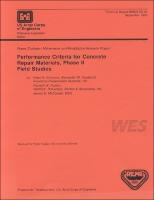Please use this identifier to cite or link to this item:
https://hdl.handle.net/11681/4444| Title: | Performance criteria for concrete repair materials. Phase II, Field studies |
| Authors: | Structural Preservation Systems, Inc. Whitlock, Dalrymple, Poston & Associates Repair, Evaluation, Maintenance, and Rehabilitation Research Program (U.S.) Emmons, Peter H. Emmons, Peter H. Poston, R. W. McDonald, J. E. (James E.) |
| Keywords: | Concrete Concrete repair Concrete properties Expansion Contraction Maintenance Repairs Concrete structures Coefficient of thermal expansion Compressive creep Drying shrinkage Material properties Modulus of elasticity Performance criteria Tensile strength Tensile creep |
| Publisher: | Cold Regions Research and Engineering Laboratory (U.S.) Engineer Research and Development Center (U.S.) |
| Description: | Technical report Abstract: The study reported herein is part of an overall investigation to develop performance criteria for cement-based materials. Preliminary performance criteria for dimensionally compatible repair materials were proposed in Phase I of the study. Laboratory and field tests to evaluate these criteria were conducted in Phase II of the project. The field-testing program described herein included installation of 12 selected cementitious repair materials in prefabricated repair cavities at each of three test sites and monitoring their performance during an 18-month period following installation. The test sites were selected to provide a wide variation in exposure conditions ranging from the hot and dry conditions encountered in Arizona, to hot and humid conditions encountered in Florida, to the northern climate of [llinois. In addition to the simulated repairs, the field performance of each material was evaluated with two restrained dying shrinkage test methods. Relative rankings of the materials were developed based on their field performance with resistance to cracking being the predominate factor in these rankings. Six materials demonstrated satisfactory performance regardless of exposure conditions. Two materials were susceptible to cracking at only one test site, and their performance is rated as marginal. The remaining four materials exhibited cracking in each exposure condition, and their performance is rated as unsatisfactory. |
| Rights: | Approved for public release; distribution is unlimited. |
| URI: | http://hdl.handle.net/11681/4444 |
| Appears in Collections: | Technical Report |
